stylistics rhetoric 3-2 词汇层面,修辞
- 格式:ppt
- 大小:544.50 KB
- 文档页数:26
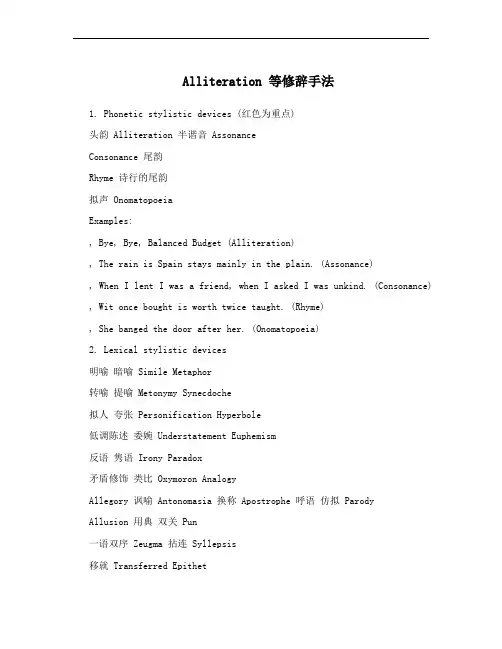
Alliteration 等修辞手法1. Phonetic stylistic devices (红色为重点)头韵 Alliteration 半谐音 AssonanceConsonance 尾韵Rhyme 诗行的尾韵拟声 OnomatopoeiaExamples:, Bye, Bye, Balanced Budget (Alliteration), The rain is Spain stays mainly in the plain. (Assonance), When I lent I was a friend, when I asked I was unkind. (Consonance) , Wit once bought is worth twice taught. (Rhyme), She banged the door after her. (Onomatopoeia)2. Lexical stylistic devices明喻暗喻 Simile Metaphor转喻提喻 Metonymy Synecdoche拟人夸张 Personification Hyperbole低调陈述委婉 Understatement Euphemism反语隽语 Irony Paradox矛盾修饰类比 Oxymoron AnalogyAllegory 讽喻 Antonomasia 换称 Apostrophe 呼语仿拟 ParodyAllusion 用典双关 Pun一语双序 Zeugma 拈连 Syllepsis移就 Transferred EpithetExamples:1) The old man’s hand trembled like a leaf. (simile)2) He is as sly as a fox. (simile)3) Be careful of that thief; he is a slippery customer. (metaphor)4) The parks are the lungs of our city. (metaphor)5) He drank a cup. (metonymy) (代替杯中酒)6) He was steeped in Shakespeare. (metonymy) (代替他的作品)7) Two heads are better than one. (synecdoche) (部分代替整体)8) The trees and flowers around them danced heartily as if touchedby merry mood. (personification)9) I sat for a while, frozen with horror. (hyperbole)10) I was not a little surprised at the news. (understatement)11) The teachers say my son is slow. (euphemism)12) He is a man who is most dependable when you are not in need. (irony)13) The Child is father of the Man. (paradox)14) More haste, less speed. (paradox)15) bitter-sweet memories (oxymoron)16) It’s with our judgments as with our watches; none go just alike, yet each believes his own.(analogy)17) No rose without a thorn. (allegory)18) All that glisters is not gold. (allegory)19) Uncle Sam (美国) (Antonomasia )20) Romeo (情郎 ) (Antonomasia)21) England! awake! awake! awake! (Apostrophe)22) Quality breeds success. (仿Familiarity breeds contempt.) (Parody)23) “You want your pound of flesh, don’t you?” (来自“TheMerchant of Venice by Shakespeare”) (A llusion )24) a surprised silence (Transferred Epithet )25) We spent an anxious night. (Transferred Epithet ) 26) On Sunday they pray for you and on Monday they prey on you. (pun) 27) But acannon-ball took off his legs,So he laid down his arms. (Pun )28) She went home in a flood of tears and a sedan-chair. (Syllepsis) (两个短语都能搭配) 29) He lost the game and his temper. (Syllepsis ) (两个短语都能搭配)30) weeping eyes and hearts (Zeugma ) (只有一个是合理的搭配)31) The woman opened the door and her heart to the homeless boy. (Zeugma ) (只有一个是合理的搭配)3. Syntactical stylistic devicesReverse 序换 Anadiplosis 蝉联 Regression 回环 Epigram 警句反复 Anaphora 首语反复 RepetitionEpiphora 尾语反复平行结构 ParallelismAntithesis 平行对照 Rhetorical Question 设问 Climax 渐进突降 Anti-climaxExamples:, Like son, like father. (Reverse)来自Like father, like son., With Bewick on my knee, I was then happy: happy at least in my way. (Anadiplosis ), It is better to make friends fast than to make fast friends. (Regression ), It is a wise father that knows his own child. (Epigram ), We have but one aim and one single, irrevocable purpose. (Repetition), Give me the splendid silent sun with all his beams dazzling,Give me juicy autumnal fruit ripe and red from the orchard.Give me a field where the unmowed grass grows,Give me an arbour, give me the trellised grape… (Anaphora), “It’s their wealth and security that makes everything possible; makes you art possible, makesliterature, science, even religion possible.” (Epiphora), Their sun-burned faces were dark, and their sun-whipped eyes were light. (Parallelism), Speech is silver; silence is golden. (Antithesis ), Can a man be too cruel to his mother’s enemy? (RhetoricalQuestion ), I am sorry, I am so very sorry. I am so extremely sorry. (climax) , I lost my bag and with it, my wallet, my ID card, and my dirty socks. (Anti-climax)。
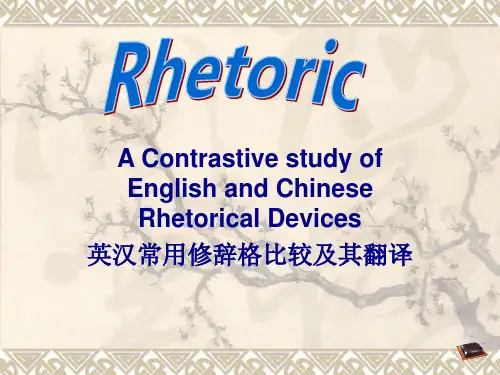
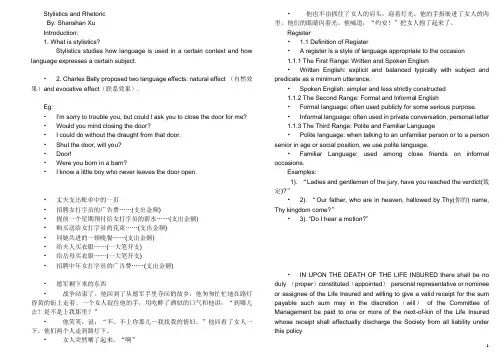
Stylistics and RhetoricBy: Shanshan XuIntroduction:1. What is stylistics?Stylistics studies how language is used in a certain context and how language expresses a certain subject.• 2. Charles Bally proposed two language effects: natural effect (自然效果)and evocative effect(联系效果).Eg:•I’m sorry to trouble you, but could I ask you to close the door for me?•Would you mind closing the door?•I could do without the draught from that door.•Shut the door, will you?•Door!•Were you born in a barn?•I know a little boy who never leaves the door open.•丈夫支出账单中的一页•招聘女打字员的广告费……(支出金额)•提前一个星期预付给女打字员的薪水……(支出金额)•购买送给女打字员的花束……(支出金额)•同她共进的一顿晚餐……(支出金额)•给夫人买衣服……(一大笔开支)•给岳母买衣服……(一大笔开支)•招聘中年女打字员的广告费……(支出金额)•德军剩下来的东西•战争结束了。
他回到了从德军手里夺回的故乡,他匆匆忙忙地在路灯昏黄的街上走着。
一个女人捉住他的手,用吃醉了酒似的口气和他讲:“到哪儿去?是不是上我那里?”•他笑笑,说:“不。
不上你那儿—我找我的情妇。
”他回看了女人一下。
他们两个人走到路灯下。

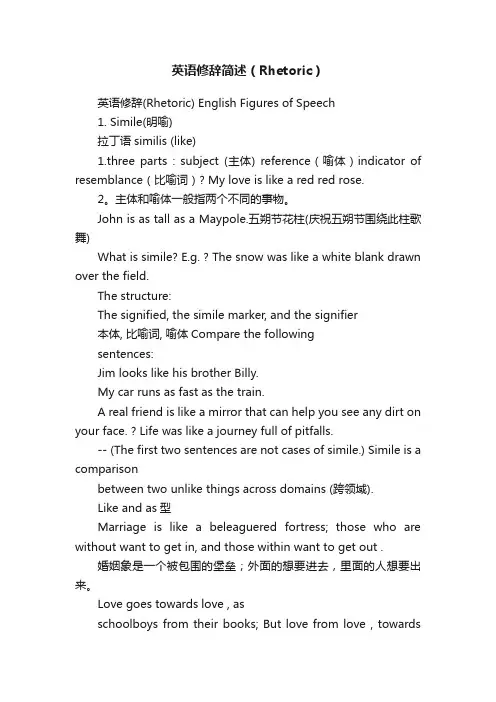
英语修辞简述(Rhetoric)英语修辞(Rhetoric) English Figures of Speech1. Simile(明喻)拉丁语similis (like)1.three parts : subject (主体) reference(喻体)indicator of resemblance(比喻词)? My love is like a red red rose.2。
主体和喻体一般指两个不同的事物。
John is as tall as a Maypole.五朔节花柱(庆祝五朔节围绕此柱歌舞)What is simile? E.g. ? The snow was like a white blank drawn over the field.The structure:The signified, the simile marker, and the signifier本体, 比喻词, 喻体Compare the followingsentences:Jim looks like his brother Billy.My car runs as fast as the train.A real friend is like a mirror that can help you see any dirt on your face. ? Life was like a journey full of pitfalls.-- (The first two sentences are not cases of simile.) Simile is a comparisonbetween two unlike things across domains (跨领域).Like and as型Marriage is like a beleaguered fortress; those who are without want to get in, and those within want to get out .婚姻象是一个被包围的堡垒;外面的想要进去,里面的人想要出来。
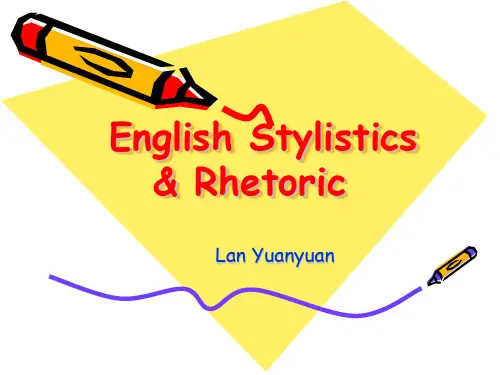
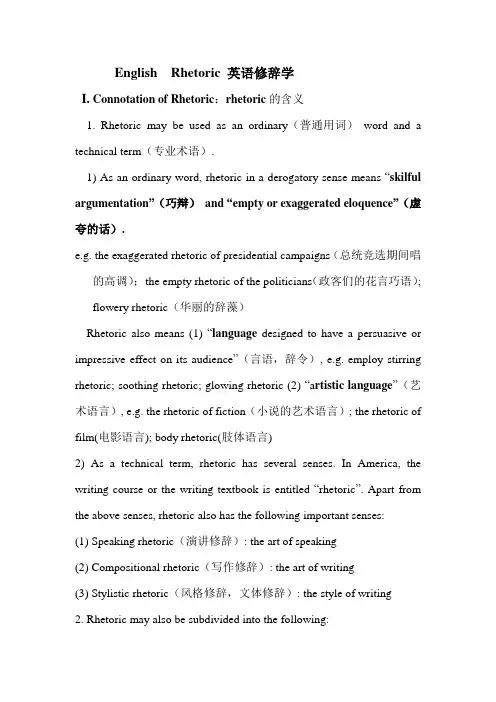
English Rhetoric 英语修辞学I. Connotation of Rhetoric:rhetoric的含义1. Rhetoric may be used as an ordinary(普通用词)word and a technical term(专业术语).1) As an ordinary word, rhetoric in a derogatory sense means “skilful argumentation”(巧辩)and “empty or exaggerated eloquence”(虚夸的话).e.g. the exaggerated rhetoric of presidential campaigns(总统竞选期间唱的高调);the empty rhetoric of the politicians(政客们的花言巧语);flowery rhetoric(华丽的辞藻)Rhetoric also means (1) “language designed to have a persuasive or impressive effect on its audience”(言语,辞令), e.g. employ stirring rhetoric; soothing rhetoric; glowing rhetoric (2) “a rtistic language”(艺术语言), e.g. the rhetoric of fiction(小说的艺术语言); the rhetoric of film(电影语言); body rhetoric(肢体语言)2) As a technical term, rhetoric has several senses. In America, the writing course or the writing textbook is entitled “rhetoric”. Apart from the above senses, rhetoric also has the following important senses:(1) Speaking rhetoric(演讲修辞): the art of speaking(2) Compositional rhetoric(写作修辞): the art of writing(3) Stylistic rhetoric(风格修辞,文体修辞): the style of writing2. Rhetoric may also be subdivided into the following:1) Lexical rhetoric(词汇修辞):the rhetorical law of choosing words and phrases2) Sentence rhetoric(句子修辞):the rhetorical law selecting sentence patterns3) Paragraph rhetoric(段落修辞):the rhetorical law of organizing paragraphs4) textual rhetoric(语篇修辞):the rhetorical law of organizing textsII. Definition of Rhetoric修辞学的定义What is rhetoric ?1.Origin of modern rhetoric: 现代修辞学的起源Rhetoric originated in “speaking”(说话). Aristotle(亚里士多得), in the 4th century BC, first defined rhetoric as the art of persuasion, equivalent to argumentation as people understand today. John Locke(约翰.洛克), English philosopher of the late 17th century, described rhetoric as “the science of oratory(演说术)” or “the art of speaking with propriety, elegance and force(修辞学是说话得体、优美和有力的艺术)”. All this explains why the word “rhetoric” means “speaking”in such European languages as Greek, Latin, French, Spanish and Italian. In the book Modern Rhetoric by American linguists Brooks(布鲁克斯)and Warren(沃伦)rhetoric is defined as “the art of using language effectively(修辞学是有效地使用语言的艺术)”.In the New Oxford Dictionary of English rhetoric is described as “the art of effective or persuasive speaking or writing, especially the exploitation of figures of speech or other compositional techniques(修辞学是有效或有说服力的演说或写作的艺术,特别是运用英语修辞格或其它写作的艺术)”.2.Rhetoric and Figures of Speech:Figures of speech are quite different from rhetoric, but they are important components in English rhetoric. In the New Oxford Dictionary of English, “figure of speech” is defined as “ a word or phrase used in a non-literal sense too add rhetorical force or interest to a spoken or written passage”(修辞格是用一个非字面意义的单词或短语使一段口头或笔头的文字增加修辞效果或兴趣). They refer to rhetorical devices(修辞手段), each of which has a fixed pattern, e.g. Simile is introduced by comparative words as, like, as if, as though, etc.; Like Simile, Metaphor refers to the comparison of two essentially unlike things which have one point of resemblance;Irony refers to the intended implication of which is the opposite of the literal sense of words; Oxymoron refers to the conjunction of two words or phrases which are incongruous or contradictory in sense so as to describe a person or thing; Pun; a play on words, sometimes on different senses of the same word and sometimes onthe similar sense or sound of different words; etc. These figures are employed in the following.He is as stupid as a goose. (=He is very stupid.)He has a heart of stone./ He has a heart like flint.(=He is unfeeling and stubborn.)He slept like a log / top. (=He slept very soundly.)They are birds of a feather. (=They are people of the same sort.) (Simile and metaphor are used of the comparison of two essentially unlike things which have one point of resemblance.) This hard-working boy seldom reads more than an hour per week. (If a boy seldom reads more than an hour per week, he must be very lazy, not hard-working.)(Irony refers to the intended implication being the opposite of the literal sense of words)He seems to be a clever fool. (=He seems to be a fool, but in fact he is very clever.)(Oxymoron refers to the conjunction of two words or phrases which are incongruous or contradictory in sense)Ask for me tomorrow and you shall find me a grave man.(grave: adj. serious; n. tomb The speaker stresses the latter.) (Pun refers to a play on words,sometimes on different senses of the same word and sometimes on the similar sense or sound ofdifferent words)3.The difference between rhetoric and grammar, phonetics,lexicolog y1)The difference between rhetoric and grammarRhetoric is different from grammar, but it is closely related to grammar and also based on grammar. To be grammatically correct is foundation to writing, but it is not enough. Basic rhetorical requirements must also be met. Francis Christensenn, an American French rhetorician, once said:Grammar maps out the possible(计划可能发生的事情);rhetoric narrows the possible down to the desirable and effective (使可能发生的事情变成很理想的事情或有效地事情).In the preface to the book A handbook of English Rhetoric Warren quoted a passage by a scholar:Grammar is the law of language, considered as language;rhetoric is the art of language, considered as thought.Grammar tells what is correct; rhetoric tells what is effective and pleasing.2)Rhetoric and phonetics, lexicologyRhetoric is quite different from phonetics and lexicology. Phonetics is about the study of speech sounds and their pronunciation;lexicology is about the study of the vocabulary of a language;grammar concerns the study or science of rules for forming words and combining them into sentences; whereas rhetoric is the art of speaking or writing so as to persuade people effectively.I II. The Object of the Study of Rhetoric(修辞学研究的内容)Rhetoric aims at studying all forms of culture, which may be forms of mass media or any cultural phenomenon, concrete or abstract. Modern rhetoric seems to include all forms of discourse ---- written or colloquial, even all forms of communication in symbols.(修辞学研究的对象是一切文化形式,它们可以是任何这样或那样、具体或抽象的文化现象。
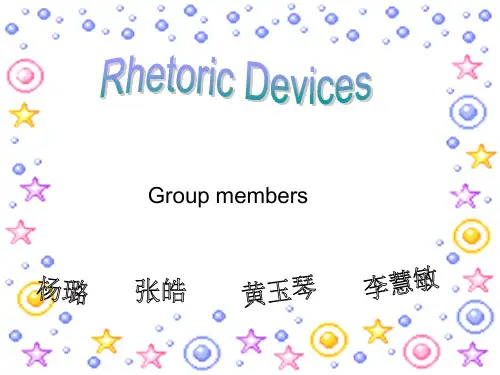
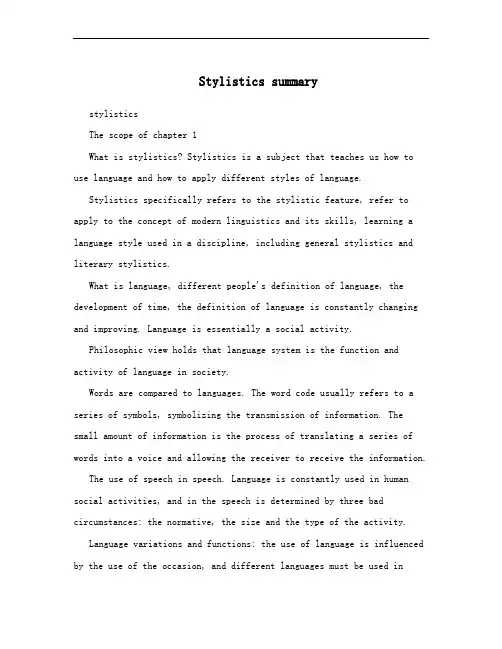
Stylistics summarystylisticsThe scope of chapter 1What is stylistics? Stylistics is a subject that teaches us how touse language and how to apply different styles of language.Stylistics specifically refers to the stylistic feature, refer to apply to the concept of modern linguistics and its skills, learning a language style used in a discipline, including general stylistics and literary stylistics.What is language, different people's definition of language, the development of time, the definition of language is constantly changing and improving. Language is essentially a social activity.Philosophic view holds that language system is the function and activity of language in society.Words are compared to languages. The word code usually refers to a series of symbols, symbolizing the transmission of information. Thesmall amount of information is the process of translating a series of words into a voice and allowing the receiver to receive the information.The use of speech in speech. Language is constantly used in human social activities, and in the speech is determined by three bad circumstances: the normative, the size and the type of the activity.Language variations and functions: the use of language is influenced by the use of the occasion, and different languages must be used indifferent contexts. Different scenes, different people, different times, different places, different media, different social situations use different languages.Language in this ancient, script and spoken English, have a conceptof function and functional points (a service for expression of speaker, a service) for writing the real world.Style is the key to distinguishing between different language habits. Each person has their own language style. For example, "the salsa style." A style is a person's language habit and a group language.The study of style: the study of stylistics is called style, and the study of stylistics is very early in the west. And stylistics as an independent language specification we need to have a full understanding to him, stylistic study of learning style tend to be more standardized, theoretical, make a linguistic description of the more strict specification.The learning of stylistics is the essence of modern science. It hasto do with literature; She is the continuation and development of rhetoric; He approaches critical literature with a new image andprovides a point of support for it.The second chapter is necessary to study the stylisticsThe study of stylistics helps us to develop a correct sense oflanguage.Language is not a unifying phenomenon. He is a broad collection.Only in different situations can people communicate properly withdifferent correct languages. Therefore, it is necessary to cultivate a good sense of language that makes it easier for us to communicate.The study of stylistics makes it easier to understand and appreciate the work of literature.In critical literature, there are three stages: the descriptive stage, the interpretation stage and the evaluation stage. In literary creation, the author will continue to make the choice and judgment of language, including the choice of words and sentence structure. When we interrupt the regular use of a new language structure, we call it "variation." This is called "repetition" when we overuse a structure. This departure from the reader's mind is a psychological one.In addition to the prospect,Some authors also for some special effect, a large number of imitation, some of great lethality is because they are significant difference between the novel and drama opened the way you talk, use a lot of dialect makes the language more vivid, close to life.Study of stylistics helps us gains in terms of translation, the role of language in different function in a different language series, each kind of display is the same rule of language features, the translation is not enough to simply express the original meaning of a sentence. The translation must conformto the meaning of the language, which should be combined with the structure of the sentence and the analysis of the style, which makes the translation of the language more perfect. In translation, it isnecessary to put our energy in the same height, the same level, as the sentence.Chapter 3: variations of languageIncludes the dialect variant and the language domain variantDifferent characteristics of speech in different bad circumstances make the language different. The learning of language features has evolved, and modern linguistics has been divided into a series of divisions.Dialect variants are divided according to the user's differences; The language domain variant is determined by the use of bad situations.Dialects can be divided into individual dialects, time dialects, regional dialects, social dialects, and standard dialects. Social dialects can be subdivided into socioeconomic status variations, ethnic variations, gender variations, age variations.The language domain includes: the range of discourse, the way of discourse, the concept of the tone of the discourse.Most of our work has to do with our work, which is to use different languages for our different jobs. Discourse means the tools that language users use when communicating. The tone ofthe speech is about the relationship between the individual and the speaker/writer, listener/reader. A series of actions spoken by language speakers for speech purposes are called functional language.The presence of a variation in the language domain helps us get alot of information about a person, such as who we can judge from aperson's accent.The language domain and the dialect are interdependent. Language variants are of great social significanceThe purpose of language description in literature. In this relationship, it is to prove the theoretical analysis. At the level, language can be divided into: vocabulary, grammar, phonetics/handwriting.The grammar level can be divided into grammar and syntax; Grammar is the key of linguistics. In the study of lexical learning, the choice of special terms, the analysis of linguistic level.Stylistic feature mainly appear in semantics, grammar and vocabulary phonetics graphology, in the first level in stylistic feature, semantic features are: the segmental features (onomatopoeia, phonetic symbols, sound assimilation, alliteration/half harmonics), super sound characteristics (melody). A feature (rereading, rhythm, intonation,pitch/pitch/pitch/pitch/pitch/pitch/pitch/sound).The second level of stylistic features: grammatical featuresshould be considered in terms of words. The types of sentences are: statements, questions, imperative sentences, sentences, sentences, sentences, sentences, sentences, sentences, sentences, sentences, sentences, sentences, sentences, sentences, sentences, sentences, sentences, sentences, sentences, sentences, sentences, sentences, sentences, sentences, sentences, sentences, sentences, sentences,sentences, sentences, sentences, sentences, sentences, sentences, sentences, sentences, sentences, sentences, sentences, sentences, sentences Clause/sentence types are: independent, non-independent, non-finite, and sentence elements.Phrases (nouns, pronouns, numerals, non-qualifier and noun structure (noun pre/post phrases); Verb phrase (verb, prepositional verb), passive and abbreviative.The word types have (roots, prefixes, suffixes) the high frequency compound words, composite words, mixtures, temporary words, conversions and pun.The general tendency is to notice six "no matter" and connotation, denotation, jargon, new words, and slang. Notice the combination of words.Stylistics third level: the semantic unit, linguistic connection [word cohesion should pay attention to the turning point ofwords/phrases, grammar structure of ellipsis, substitution, refers to each other on the (refers to, refer to below), vocabulary reuse three aspects], segmentation, discourse/textual patterns, rhetoric (metaphor meaning [metaphor, metonymy], ridiculous words and deeds cheat)/rhetoric/escape situation, semantic role.Note the four steps, the actual description and the analysis of the linguistic description.Chapter v the comparison of formal language of formal languageThe interpersonal function of language, the function that surrounds language, the interpersonal function that speaks language. Further theformal degree of language, functional language and formal degree. There are five levels of classification: informal, formal, z...The formal and phonetic characteristics of the language: the formal and informal language of the language depends on our words, the relationship to phonology, syntax rules, semantics.To establish a similar characteristic, the formal and informal language of the language depends on the vocabulary, phonology morphology, syntactic semantics. The article finally explains the difference between the content of the intervention and the informal language.Chapter 6 comparisons of spoken and written languagesProminent differences: different listening/readers, different linguistic, and different preparation statesThe difference of stylistics: speaking and writing are different in grammar, and different in terms of vocabulary, but also inphonetics/handwriting. After telling the difference between the two, there are plenty of examples to compare thetwo.The more subtle difference between the way of discourse: the difference in lifestyle, the way in which it is written,It includes: style, tone, rangeChapter 7 English conversationThe text tells the necessity of learning how to speak, the necessity of learning the conversation.Learning content of the session: economy, politics, theinternational situation, culture, education, science, sports, entertainment, news, family, children, the friendship, the weather, andso on.Adapt to the way the session is copied. The text lists many examplesof informal conversationsGeneral characteristics of English conversation:In terms of language levels of stylistic feature: grammatical features, preference for short and loose sentence, often adapt toelliptical sentence and incomplete sentences, often adapt to questions, using a simple noun and verb phrase structure; Vocabularycharacteristics, like to use short words and inaccurate expression, high frequency of acronyms, idioms, and a lot of phrasal verbs, use exaggerated words and slang. In phonetic features, the frequent use of some basic metrical features, the rhythmic variation in the tones, andtheemergence of the sublinguistic effects of freedom; A series of viewson semantic characteristics,Rough synonyms, even using illogical languages.Summary: the conversation sometimes relies heavily on the bad background knowledge of the time.Other session types include: discussion, telephone conversation, etc.。
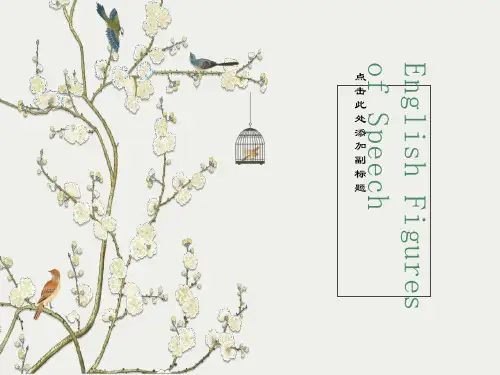
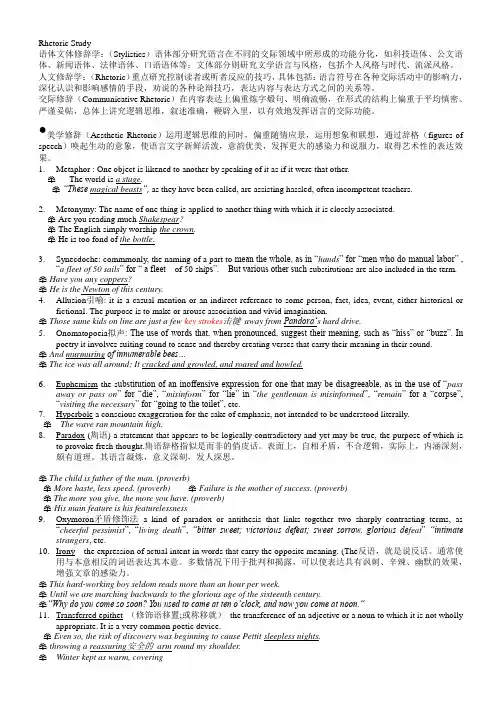
Rhetoric Study语体文体修辞学:(Stylistics)语体部分研究语言在不同的交际领域中所形成的功能分化,如科技语体、公文语体、新闻语体、法律语体、口语语体等;文体部分则研究文学语言与风格,包括个人风格与时代、流派风格。
人文修辞学:(Rhetoric)重点研究控制读者或听者反应的技巧,具体包括:语言符号在各种交际活动中的影响力,深化认识和影响感情的手段,劝说的各种论辩技巧,表达内容与表达方式之间的关系等。
交际修辞(Communicative Rhetoric)在内容表达上偏重炼字煅句、明确流畅,在形式的结构上偏重于平均慎密、严谨妥帖,总体上讲究逻辑思维,叙述准确,鞭辟入里,以有效地发挥语言的交际功能。
•美学修辞(Aesthetic Rhetoric)运用逻辑思维的同时,偏重随情应景,运用想象和联想,通过辞格(figures ofspeech)唤起生动的意象,使语言文字新鲜活泼,意韵优美,发挥更大的感染力和说服力,取得艺术性的表达效果。
1.Metaphor : One object is likened to another by speaking of it as if it were that other.The world is a stage.“These magical beasts”, as they have been called, are assisting hassled, often incompetent teachers.2.Metonymy: The name of one thing is applied to another thing with which it is closely associated.Are you reading much Shakespear?The English simply worship the crown.He is too fond of the bottle.3.Synecdoche: commmonly, the naming of a part to mean the whole, as in “hands” for “men who do manual labor” ,“a fleet of 50 sails” for “ a fleet of 50 shi ps”. But various other such substitutions are also included in the term. Have you any coppers?He is the Newton of this century.4.Allusion引喻: it is a casual mention or an indirect reference to some person, fact, idea, event, either historical orfictional. The purpose is to make or arouse association and vivid imagination.Those same kids on line are just a few key strokes击键away from Pandora’s hard drive.5.Onomatopoeia拟声: The use of words that, when pronounced, suggest their meaning, such as “hiss” or “buzz”. Inpoetry it involves suiting sound to sense and thereby creating verses that carry their meaning in their sound.And murmuring of innumerable bees…The ice was all around; It cracked and growled, and roared and howled.6.Euphemism the s ubstitution of an inoffensive expression for one that may be disagreeable, as in the use of “passaway or pass on” for “die”, “misinform” for “lie” in “the gentleman is misinformed”, “remain” for a “corpse”, “visiting the necessary” for “going to the toilet”, etc.7.Hyperbole a conscious exaggeration for the sake of emphasis, not intended to be understood literally.The wave ran mountain high.8.Paradox (雋语) a statement that appears to be logically contradictory and yet may be true, the purpose of which isto provoke fresh thought.雋语辞格指似是而非的俏皮话。
大学英语修辞格大学英语常见修辞格所谓修辞是指依据题旨情境恰当地选择语言手段和表达方式, 以有效地表情达意。
修辞的目的是使作品更加形象生动、引人入胜。
了解英语中的修辞, 有助于我们更好地理解、欣赏文章,也有助于在写作中丰富我们自己的表达。
英语修辞格按其构成大致可以分为三类:(一)词义修辞格(Lexical Rhetorical Devices)词义修辞格主要是指借助语义的联想和语言的变化等特点创造出来的修辞手法。
大学英语中常见的词义修辞格有以下几种:1. Simile 明喻与汉语的明喻基本相同,是以两种具有相同特征的事物和现象进行对比,表明本体和喻体之间的相似关系。
常用来表示明喻的喻词有like, as, as if, as though等。
如:Learning is like rowing upstream; not to advance is to drop back. 学如逆水行舟,不进则退。
2. Metaphor 暗喻暗喻也是一种比喻, 但不用比喻词, 因此被称为"缩减了的明喻(a compressed simile)"。
它是根据两个事物间的某些共同的特征, 用一事物去暗示另一事物的比喻方式。
如:And yet, while most of us are only too ready to apply to others the cold wind of criticism, we are somehow reluctant to give our fellows the warm sunshine of praise. 但是,尽管我们中的很多人太容易给别人批评的冷风,却不知何故不愿意给我们的同伴赞扬的阳光。
(该句中,将criticism比喻成cold wind,将praise比喻成warm sunshine,但是未使用任何比喻词,因此为暗喻。
)3. Metonymy转喻/借代转喻类似于汉语中的借代修辞,是通过相近的联想, 借喻体代替本体,它根本不说出本体事物, 直接用比喻事物代替本体事物。
1. stylistics: a branch of linguistics which studies style in a scientific and systematic way concerning the manners / linguistic features of different varieties of language at different levels.2. style: Manner indicating prominent linguistic features, devices or patterns, most (or least) frequently occur in a particular text of a particular variety of language.3. register语域:Registers are language variations that are associated with the different use to which they are put. Such varieties do not depend on the people who use the language, but on the occasion when it is used.4. field of discourse: the linguistic reflection of the purposive role of the language user, --the type of social activity the language user is engaged in doing in the situation in which the text has occurred. That is to say, the language the user uses will show what his/her language is 'about', what experience he/she is verbalizing, what is 'going on' in the speech event.5. tenor of discourse: the linguistic reflection of the personal relationships between speaker/writer and hearer/reader—called PERSONAL TENOR(个人基调), and of what the user is trying to do with language for/to his or her addressee (s) -- called FUNCTIONAL TENOR(功能基调).6. mode of discourse: the linguistic reflection of the relationship that the language user has to the medium of communication.7. foregrounding Foregrounding, giving unusual prominence to one element or property of a text, relative to other less noticeable aspects. According to the theories of Russian Formalism, literary works are special by virtue of the fact that they foreground their own linguistic status, thus drawing attention to how they say something rather than to what they say: poetry …deviates‟ from everyday speech and from prose by using mete r, surprising metaphors, alliteration, and other devices by which its language draws attention to itself.8. deviationDeviation : a variation that deviates from the standard or norm;∙ the breaking of normal rules of linguistic structure;∙violation of the norms;∙Departure from general order9. loose sentence松散句A sentence that completes the main thought well before the end is called loose sentence, which often occurs in conversations or informal writings.10. periodic sentence掉尾句is a sentence which suspends the completion of the main thought until(near) the end.11. Gobbledygook官样文章Bureaucratic writings are often referred to as “gobbledygook” , because they are written in an obscure and complex style, which to some extent may help to impress, to mislead or deceive the public.12. accessibility, Accessibility means whether a piece of language is easy to understand for the addressee. As the language becomes more formal, more impersonal, more specialized in certain subject matter, it tends to become less accessible to the ordinary reader or listener.13. impersonalityImpersonality reflects the extent to which the producer of a text avoids reference to himself/herself or to the reader.14. degrees of formalityFormality refers to the way in which the style or tone of language will vary in appropriateness according to the social context. The degrees of formality are determined by the role relationships, number of hearers, and contexts of situation, such as a public lecture, church service, cocktail party, and so on.15. politenessPoliteness refers to(1) How languages expressed the social distance between the speakers and their different role-relationships;(2) How face-work, that is, the attempt to establish, maintain, and save face during conversation, is carried out in a speech community.16. iamb抑扬格It has a pattern alternating stressed and unstressed syllables beginning with an unstressed syllable.17. trochee扬抑格Trochee or trochaic foot may be described as alternating stressed and unstressed syllables, beginning with a stressed syllable.18.meter 格律 Metre (格律,韵律)refers to an organized pattern of strong and weak syllables.19.Foot (音步)refers to the span of stressed and unstressed syllables that form a rhythmical pattern.20. fog index迷雾指数The fog index is commonly used to confirm that text can be read easily by the intended audience.Fog index = 0.4(L+H)L=the average sentence length in a passageH= the percentage of hard words in the passageTexts for a wide audience generally need a fog index less than 12.Texts requiring near-universal understanding generally need an index less than 8.。
DefinitionChapter11.Stylistics is an area of study which straddles two disciplines: literary criticism andlinguistics. Besides, it is directly related to literary interpretation, and make use of linguistic facts and theory.Chapter22. Style as deviance refers to the distinctiveness of a literary text resides in its departure from the characteristics of what is communicatively normal.e.g. p13The phrase “a grief ago” from a poem of that name by Dylan Thomas.It violates two rules of English: a) the indefinite article a clashes syntactically with the uncountable noun grief; b) the post modifying adverb ago clashes semantically with the head word grief. The highly deviant nature of the phrase attracts much attention from the reader to itself, and thus makes it possible for the poet to express what cannot be expressed through the normal use of language.(汪洁)3. By style as choice is meant that style results from a tendency of a speaker or writer to consistently choose certain structures over others available in the language.e.g.In writing The Eve of St. Agnes, Keats first produced the line, “As though a rose should close and be a bud again”. But when he re-read the line, he substituted the word shut for close:”As though a rose should shut and be a bud again”4. The view of style as foregrounding is a further view of style which appears to be a compromise between view of style as deviance and view of style as choice. The term foregrounding is a concept of pictorial arts, referring to that part of the composition that appears to be closest to the view.e.g. P19When he laughed, respectable senators burst with laughter,And when he cried the little children died in the streets.(W.H. Auden, Epitaph on a Tyrant)Auden could have chosen a different structure for each line, yet he limited himself to the same option. The parallel structure here draws the attention of the reader and makes him see the sematic connection between the two lines. This is a type of foregrounding.(汪洁)Chapter 35. Grammetrics: the ways in which grammatical units are fitted into metrical units such as lines and stanzas.e.g.P35This Is Just to SayI have eatenthe plumsthat were inthe ice-boxand whichyou were probablysavingfor breakfastForgive methey were deliciousso sweetand so coldIt creates a pulling-forward effect. In one line, although the verb eat can either take an object or not, the absence of punctuation at the end of the line makes us expect one. Thus we are driven forward to the second line where our expectation is satisfied.(章嫣羚)6. Affixation: is the addition of a prefix or suffix to an item which already exists in the language.e.g. P46And I Tiresias have foresuffered all. (T.S.Eliot)The nonce word foresuffered is coined by adding the prefix …fore-‟to the item …suffer‟. The prefix …fore-‟conveys the meaning …beforehand‟and is normally reserved for joining with such items as …see‟, …tell‟ and …warn‟. The novel use here, according to Leech, encapsulates a newly formulated idea: it is possible to anticipate mystically the suffering of the future, just as it is possible to …foresee‟ and …foretell‟ or to have …foreknowledge‟ of the future events.(章嫣羚)7. Graphology: the encoding of meaning in visual symbols.e.g.P30Graphological deviation can occur in any sub-area of graphology, such as the shape of the text, the type of print, grammetrics, punctuation, in-dentation, etc. [Thematic-fronting]8. Marked theme: The initial unit of a clause may be called its theme. The rest of clause elements might be put in the thematic position in order to achieve certain literary effect. The theme thus produced is unusual and is therefore called a “marked “ theme. E,g. P40My opinion of the coal trade on that river is, that it may require talent, but it certainly requires capital. Talent Mr. Micawber has, capital Mr. Micawber has not. (D ickens, David Copper field).In the second sentence, two objects----talent and capital were placed in the front of each clause. The function of the unusual clause theme seems to be three-fold: a) it neatly knits the paragraph together and is thus a powerful device of textual cohesion, b) it serves to form a contract in meaning between the two parallel clauses, c) it gives much emphasis to the two words shifted to the initial position.(屈静华)9. compounding: compounding is the combination of two or more items to make a single compound one. NE,g.P47While I, joy-jumping, empty-eyed sang on the day my father died.( Edwin Brook)In this sentence, joy-jumping is a compound made up on the pattern of noun + “ing” participle. This word coined from the idiom “ jump for joy” which means “jump because of joy”. The day when “my” father died cannot be a happy day. Therefore, the extension of the compound rule here on an idiom makes the situation describes in the poem much more ironical.The word empty-eyed is also a compound. It means “on the day my father died”“ there are no tears in …my‟ eyes”. Here, the ironical effect is further reinforced and developed.(屈静华)10. Aphesis: the omission of an initial part of a word.E,g.Thou on whose stream, ‟mid the steep sky‟s commotion,Loose clouds like earth‟s decaying leaves are shed, (P.B. Shelley, Ode to the West Wind) The complete form of mid‟ in the line is …amid‟.(夏莹)11. Apocope: the omission of a final part of a word.E,g.Till a‟ the seas gang dry, my dear,And the rocks melt wi‟ the sunI will love thee still, my dear,While the sands o‟ life shall run.(Robert Burns, A Red, Red Rose)Here ,Burns has used a‟ for …all‟ ,wi’for …with‟ and o’ for …of‟.(夏莹)12. Conversion: which is often described as …zero affixation‟, is the adaptation of an item to a new grammatical function without changing its form.E,g.“I‟ll Golden Bull you, you rascal!” roared the Majesty of Prussia. (Macaulay)The noun phrase Golden Bull is turned to a verb to convey the meaning, to fight(someone) like a Golden Bull. Since Golden Bull was used as a proper noun in the preceding sentence, the conversation of it into a verb makes the passage highly cohesive. It also vividly manifests the boorishness of the Majesty of Prussia.(叶淑萍)13. Syncope: the omission of a medial part of a word.E,g.A voice so thrilling ne‟er was heardIn spring-time from the cuckoo-bird,Breaking the silence of the seasAmong the farthest Hebridges.(Wordsworth, The Solitary Reaper)The original form of ne‟er in the first line is “never”. It‟s a conventional licenses of verse composition. It changes the pronunciation of the original words so that the poet may better and more easily arrange sound patterns to achieve their intended communicative effects.(叶淑萍)Chapter 414. Oxymoron: It is the yoking together of two expression which are incompatible, so that in combination they have no conceivable literal reference to reality. 矛盾修辞False true /die merrily /a living death--------create the communicative effect15. Paradox: It is a statement which is absurd because it is self-evidently false. 似非而是Ignorance is strength. Express a certain truth or message through apparent falsehood.16. Metonymy: It is the substitution of a word referring to an attribute of the thing that is meant,rather than the substitution of a part for the whole,or the whole for a part. 转喻e.g. P65The glories of our blood and state,Are shadows,not substantial things;There is no armour against fate;Death lays his icy hand on kings;Sceptre and CrownMust tumble downAnd in the dust be equal madeWith the poor crooked Scythe and Spade.(Shirley,The Glories of our Blood)Sceptre and Crown are things that kings and queens carry and wear to present their power and authority, and are therefore metonyms for kings and queens. Scythe and spade are things used by peasants or farm workers, and are therefore metonyms for peasants.(冯丹)17. Synecdoche:a) It is a type of transference of meaning which involves the substitution of a part for the whole. b) It can also be interpreted more broadly to include substitution of the whole for a part. 提喻He can‟t ride a wheel. A wheel substitutes the bicycle.18. Metaphor: It is the figurative meaning is derived from the literal meaning or it is, as it were, the literal meaning. 隐喻e.g. P69The frog came on the cat‟s feet.She is really a duck, she thought.(Galsworthy,The Forsyte Saga)She is a human referent and treated either as a duck.(陈沈慧)19. Overstatement: It is termed hyperbole in traditional rhetoric. It distorts the truth by great exaggeration. It is usually used to emphasize strong feeling and to create a sentimental , satiric or comic effect.An overstatement is often metaphorical. 夸张,夸张手法e.g. P71For she was beautiful-her beauty madeThe bright world dim,and everything besideSeemed like the fleeting image of a shade.(Shelley)The overstatement her beauty made the bright world dim expresses the speaker‟s great admiration for the female figure. Actually, what the poet intends to say, put in plain terms, is that she was extraordinarily beautiful. (陈沈慧)20. Homophony: The words that have the same pronunciation but differ in form and meaning. 同音异义词e.g. P77When I am dead, I hope it may be said…His sins were scarlet,but his books are read.‟(Belloc, On his Books)When we have heard these lines we would have two simultaneous interpretations of the last lexical item: the past participle of the verb 'read 'which relates to his books and the adjective 'red' relating to its hyponym scarlet in the first half of the same line.21. Polysemy :the ambiguity of an individual word or phrase that can be used (in different contexts) to express two or more different meanings 一词多义e.g. P79Franklin:Hancock‟s right. This is our passport to the gallows. But there is no backingout now. If we don‟t hang together, we shall assuredly hang separately.(Peter Stone and Sherman Edwards, 1776)The playwrights here deliberately exploit the use of hang to mean both …put to death with a rope around the neck‟ (as in punishment for a crime) and …remain united‟ (an idiom with the word together). In this way, they have succeeded in making Franklin a witty, humorous and highly literary character, like Franklin was in person.22. Understatement: It is the opposite of overstatement in that it misrepresents the truth by deliberately understanding it as opposed to exaggerating it. In traditional rhetoric, scholars make a distinction between two types of understatement, namely litotes[a negative construction] and meiosis. 降格陈述e.g. P73The face wasn‟t a bad one; It had what they called charm.(Galsworthy)The face wasn‟t a bad one in this context is a non-committal way of saying; the face was a very good (or charming) one.Chapter 5Define the following terms.Alliteration consonance rhymeOnomatopoeia assonance iambanapaest pentameter dactyldimeter tetrameter trochee23. Alliteration is the repetition of the initial consonant cluster in stressed syllables.Example: ‟last but not the least ‟ …now or never‟The best laid schemes o‟ mice and menGang aft a-gley(Robert Burns ,To a Mouse)Alliteration is usually used to form a connection of similarity or a connection of contrast. The alliteration in To a Mouse links mice and men seems to form a connection of both similarity and contrast. Firstly, it forms a referential contrast between man, the supreme head of animal creation, and the mouse, one of the smallest and timidest, and most inconsequential of creatures. Secondly, with the help of the conjunction and, it points out a similarity between men and mouse who as this passage suggests seem to share the vulnerability of fate. The connection between the two created by alliteration seems to emphasize the point that creatures superficially different are basically the same.24. Consonance is the repetition of the final consonant cluster in stressedsyllables.Example: P103Nothing lovelier that that lonely call,Bare and singular ,like a gullAnd there notes or four ,then that was all .It drew up from the quiet like a well ,Waited ,sang, and vanishing ,was still .(Jon Swan ,In Her Song She Is Alone )The repeated / l / sound effectively unites the key words of the stanza: caii with gull and well with still. The / l / sound in the quoted lines and elsewhere in the poem has a lingering, almost echoing effect, which greatly reinforces the tone of the poem.25. Rhyme is defined in Concise Oxford Dictionary as “identity of sounds between words or verse lines extending back from the end to the last fully accented vowel and not further”. The general function of rhymes is to get the texts more organized and to bestow “music” to the texts. It may also be used to achieve more significant effects. Example: P100For I have known them already, known them all—Have known the evenings, mornings, afternoons,I have measured out my life with coffee spoons;(T. S. Eliot, Love Song of J. Alfred Prufrock)The rhyme of the last two lines is very significant. It links together the two words, afternoons and spoons which have a logical association between them. For the words are used in a context of a poem which is about a society that spends its afternoons over coffee and cakes.26. Onomatopoeia is ambiguous and can be interpreted in several different ways. Firstly, it refers to the use of words formed in imitation of the natural sounds associated with the object or action involved.The other interpretation of onomatopoeia may be phrased as the recurrence of phonemes in a text unit that suggests certain natural sound which reinforce the meaning conveyed in that text unit.Example :P104 ,Crack came an officer‟s club on his forehead .He blinked his e yes blindly a few times ,wobbled on his legs ,threw up his hands and staggered back .(T.Dreiser,Sister Carrie)The use of crack in create a vivid effect to the passage. The sound make us hear as well as see what are described.p106.I chatter over stony ways,In little sharps and trebles,I bubble into eddying bays,I babble on the pebbles.The three onomatopoeic words chatter, bubble and babble give a vivid description tothe sounds and motion of the brook, they have brought great immediacy to the scene, make us feel as if we were right there by the brook. The description is further high-lighted by the recurring sounds /l/ and /b/. the sound /l/ belongs to a class of sound called liquid which is fluid-sounding and the sound /b/ is a plosive resembling the sound of the bubbles. Therefore, their repeated presence makes the text sound more bubbly and steam-like.27. Assonance is the repetition of identical vowel or diphthong in stressed syllables.Example:Think from how many tressDead leaves are broughtTo earth on seed or wing(Vernon Watkins ,The Compost Heap)The words that carry the assonance, as can be easily noticed, are: trees, leaves and seed. These words are stressed rhythmically in the lines. Interesting, we find that the meanings of there words are already associated. More significantly, there words may be said to represent the cycle of life: from the organic to the inorganic and from the inorganic to the organic. Thus, assonance not only contributes to musical quality if a literary text, but also to its meaning.28. Iamb is the commonest type of verse foot. It has a pattern alternating stressed and unstressed syllables beginning with an unstressed syllable.A‟/‟ to mark a stressed syllable ,and a‟V‟ to mark an unstressed syllable.Example:P111In eve/ ry cry / of eve/ ry man .In eve/ ry in/ fant‟s cry / of fear .(W.Blake ,London )In eve/ ry cry/ of eve/ ry manIn eve/ ry in fant‟s cry/ of fearall the letters in blue are unstressed syllables, and in red are stressed syllables, the poem begins with unstressed syllable, and alternating with stressed syllables.29. Anapaest is a pattern in which one stressed syllable alternates with two unstressed syllables, but beginning with the two unstressed syllables.Example:P112The Assy/rian came down /like the wolf /on the fold .(Byron ,The Destruction of Sennacherib )The Assy rain came down like the wolf on the fold.all the letters in blue are unstressed syllables, and in red are stressed syllables. The poem begins with two unstressed syllables, then following a stressed syllable. Thenthe meter keeps repeating with two unstressed syllables and a stressed syllable.32. Dimeter is a line of verse consisting of two metrical feet or of two dipodies. Example:P115∕ˇˇ∕ˇˇOne more un / fortunate∕ˇˇ∕Weary of / breath∕ˇˇ∕ˇˇRashly i m / portinate ,∕ˇˇ∕Gone to her /death!We can see there are two foots in each line.33.Tetrameter is a line of verse consisting either of four dipodies (as in classical iambic, trochaic, and anapestic verse) or four metrical feet (as in modern English verse)Example:P115ˇ∕∕∕ˇ∕ˇ∕Who fought / for free / dom, more / than lifeˇ∕ˇ∕ˇ∕ˇ∕Who gave / up all, / to die / in strife?We can see there are four foos in each line.34. Trochee may be described as alternating stressed and unstressed syllables, beginning with a stressed syllable.Example: P111/ ˇ/ˇ/ ˇ/Men of /England ,/wherefore /plough/ ˇ/ ˇ/ ˇ/For the /Lords who /lay ye/low?(P.B.Shelley,Song to the Men of the England)A‘/’to make a stressed syllable, and a‘ˇ’to make an unstressed syllable. Chapter 635. Repetition: It is restricted to mean the case of exact copying of a certain previous unit in a text, such as a word, phrase or even a sentence.重复e.g. P132Gold! Gold! Gold! Gold!Bright and yellow,hard and cold,Molten,graven,hammer‟d and roll‟d,Heavy to get and light to hold.(Thomas Hood)The word Gold is repeated four times. Reinforced by the capitalization of the first letter of the word and the exclamation mark “!”, the word attracts much attention to itself. The repetition here shows the poet‟s great intensity of feeling when talking about gold.36. Parallelism: It means exact repetition in equivalent positions. It requires some variable feature of the pattern-some contrasting elements which are parallel with respect to their position in the pattern.平行结构例子Not many lives, but only one have we; One, only one.(Anonymous, Only One Life)The word one is repeated intermittently three times and the word only twice. This greatly emphasizes the fact that there is only one life for a person and suggests that one should really treasure it.e.g. P137I came, I saw, I conquered. (Julius Caesar)试卷相关题型Stylistic analyses1.Recite one poem give stylistic analyses2.graphological features1) A Christmas TreeStarIf you areA love compassionate,You will walk with us this year,We face a glacial distance , who are hereHuddledAt your feet(W.S. Burford)p55. 4(1)In the poem, graphological feature mainly is shape of the text .The shape of the poem strikes us because it is not like that of a conventional poem. We can find that the poem is about a Christmas tree, therefore, the author wrote it in the shape of a Christmas tree. The first line includes only one word ”star”, which turns into the top of the tree; from the second line to the fifth one, from” A love compassionate” to”who are here”constitute the branches and leaves. Also, ”Huddled”makes the trunk, and :At your feet”makes the root. All of the words appear in appropriate positions from top to bottom. So, seeing the poem, all the beautiful scenes of Christmas came onto our mind, especially the happiness and love. That is the main idea poetry want us to understand.p55. 4(2)In the poem, graphological deviation mainly includes two types: the type of print and grammetrics. The type of print is menifest in the de-capitalization of the first letter of certain words. The grammetrics is shown in the following points. First, the title of the poem does not stand clearly as the usual case. Second, one sentence runs over lines, which shows the poet intends the poem to be read as a whole and places emphasis on the unity of the discourse. It can arise the reader's expectation and interest. Third, every line of the poem creates a pulling-forward effect. It is intended to make the reader actively involve himself in reading the poem with interest, curiosity and pleasure. Eg: in the first line, 'rainbow youre a two faced sort', there is an absence of an object, which makes us expect one. Thus we are driven forward to the second line where our expectation is satisfied. But a new expectation is aroused again by the presence of the forth line 'uses', we have only to read next line.l(aleaffalls)onelIness(E.E.Coummings)p56. 4(3)The whole poem is a sentence of “a leaf falls/loneliness”. The main idea of the poemis about loneliness. The shape of the poem strikes us most unusual because it is not like that a conventional poem. When we look it carefully, we may find that the poem is consist of separated words and became a list. When we see it, with our imagination, we may feel that word “leaf” in the middle like the real leaves are falling down. And the letter out of the brackets is constituted word “loneliness”. So, when we read the poem, as if it was saying that “I am like a leaf falls lonely.”3.the function of metaphor1)Sunday Rain by John UplikeThe window screenis trying to doits crossword puzzlebut appears to knowonly vertical words.Here the writer uses personification to give the window screen human attributes. When the rain falls on the window screen, the rain drops will slide vertically down to the bottom of the screen. It is like how we do a crossword puzzle, when we work out a vertically-arranged word completely, we link all the letters.How can rain drops DO crossword puzzle? How can rain drops KNOW? Apparently, the writer adds human attributes to the rain and it has special effects.2)An Empty HouseYou beat your pate, and fancy wit will come:Knock as you please, there’s nobody at home.(Alexander Pope)In this poem, Pope uses a type of metaphor that is “A non-human referent is given human attributes”. He gives “wit” human attributes and treats it as a human being, and “nobody” in the last sentence also refers to it. Besides, here “pate” means “brain” (or “head”), and Pope regards it as a house (or “home”) where “wit” lives.This metaphor is a satire of those people who are too silly or lazy to use their head. It tells us that there is no use to beat your pate foolishly when faced with a problem. Instead, you should use your head and think about the problem until you come up with any idea.3) Dreams(Langston Hughes)Hold fast to dreamsFor if dreams dieLife is a broken-winged birdThat cannot flyHold fast to dreamsFor when dreams goLife is a barren fieldFrozen with snowWritten in 1926, Dreams is one of the most famous poems of Langston Hughes's. Langston Hughes, born Feb 1, 1902, is an American poet, novelist, and playwright. And he is known for his work during Harlem Renaissance. In Dreams, Hughes is advising the readers to never stop dreaming and to never give up on a dream. Though he feels the world is a very depressing place, dreams can make it wondrous and exciting. The word "life" in the poem is described by metaphor. Life, actually, is an abstraction, but poet describes it as a broken-winged bird and a barren field, which are animate. In order to tell people to insist on dreams, poet uses the broken-winged bird which cannot fly and the barren field which is frozen with snow. The two vehicles above are like life without dreams in respect of that if there‟s no dream, life will have no freedom and joy, and it will be cold, dark, depressing and dim. So metaphor in Dreams makes the pale statements conveyed ironically and vividly.4)Ways of Composingtypewriter:a mouthful of teeth chatteringafraid to be quietA pencil can lie down and dreamdark and silver silences(Eve Merriam)1.The poet Eve Merriam is an American poet and writer who wrote for children. Therefore, in her works, she used metaphor so often that children can understand easily.2.Here, the metaphor function is: A non-human referent is given human attributes. (1)Typewriter is the tenor and a mouthful of teeth is the vehicle, the poet take typewriter as a mouthful of teeth to show children the appearance in a very interesting way.(2)A mouthful of teeth is a non-human referent, but here they are "chattering", a pencil is a non-human referent, but here it can lie down and dream, the poet gives these two non-human referents human attributes to show children that what is a typewriter, how it works and if it can take the place of pencil very vividly.5)FogCarl SandburgThe fog comes 雾来了,on little cat feet. 踏着小猫的脚步。